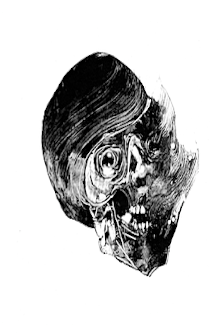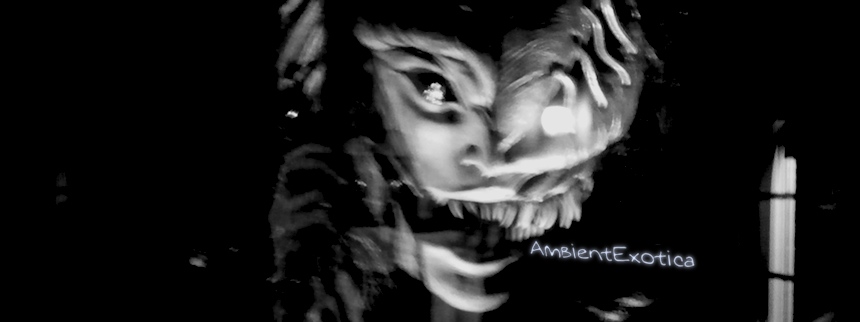
Antidröm
Antidröm
2013
Antidröm is the self-titled sophomore album by Cambridge-based guitarist and sound designer Tim Bayley and the follow-up to 2012’s tape First Things First. Spanning 14 tracks, sporting a creepy front artwork of Neo-Gothic proportions by Grady Gordon, released on The Association for Depth Sound Recordings in August 2013 and readily available to purchase and fully streamable at Bandcamp, Antidröm is a multifaceted work whose style could – and, for the moment, will – be summarized with the term Dark Ambient, but it is much more than that and breaks all genre-related chains hopeless reviewers try to impose. Oscillating between guitar-based drone layers, synth-accentuated fluxions and grinding beat structures, Dark Ambient is indeed a fitting and convenient marker… were it not for the limewashed haze and enchanting field recordings which are equipollent parts of the endemic color range. Bayley cites Autechre, Biosphere and Sunn O))) as his sources of inspiration, among others, and these acts show the variety of this project. Based in the rural fens outside Cambridge, nature also plays an important role in Antidröm’s music, but as I have implied above, it is not solely used as a bewitched location for supernatural phenomena or scarily threatening incidents, but is more often than not presented as is, with the birds chirping heartwarmingly, awash with sunlight. And this is by far not the album’s only contravening addendum. In my last sentence of this opening paragraph, I therefore suggest another trigger in addition to the Dark Ambient label: hauntology!

The six-panel heavy-card fold-out slipcase of Antidröm's limited edition shows the monoprint artwork by Grady Gordon.
The opener Love Supreme is best described with the famous internet meme “What is it, I don’t even…,” a more than poignant exclamation of bewilderment and genuine surprise that is only mildly lessened when you remember Dark Ambient luminary Svarte Greiner’s similar approach in terms of his dark matter hymn Tunnel Of Light which appeared on his sophomore album Kappe (2009). Love Supreme is what I have called a “stokehold moiré” on Twitter, a multilayered, occasionally heterodyned gallimaufry of rufescent dun-colored guitar twangs. Mephitic dust cloudlets of alkaline static noise sweep through the granular antrum, dungeonistic semi-brazen clangs and overdriven guitar protrusions round off a hopelessly crepuscular vault of the Drone kind. The follow-up Fear gets rid off these camouflage tactics, and yet does Antidröm choose a potentially wrong title, for naked, primeval fear is not injected here at all. The tune is grotesquely bouncing and bumbling along, with elasticized coils, bongo blebs and twirling laser beams united in a lacunar beat-accentuated atmosphere. Only the synth string aortas pulsate in a semi-histrionic yet galactic way, their afterglow illumining the plantation site. Naturally, the admixed brutish ramblings and stereo-panned service announcements for the forthcoming coven are not exactly gleeful, but again, Fear is decidedly uneasy and haunting, even if it is not terrifying qua its Space-Age structure.
After the blurred and sternly amplified 8-bit expectoration of the interlude Earth, it is Wraith that scares the excrements out of the listening subject’s body. Akin to Fear, it is a cleverly beat-accentuated composition, but its bit-crushed and hopelessly emaciated or desiccate vestibules to daemonic lands trigger atavistic behaviors. The bone-dry breakbeat emanates a blood-thirsty tribalism, humming guitar skeletons reel through the wasteland. Everything really does feel ardent and porose, cleverly added hall effects evoke the feeling of standing in a corridor where the plaster crumbles. Willfully repetitive and quiescently concentrated only on itself, Wraith causes fear with what little frequencies and rusty surfaces are left. The following Neuromancer is the most fitting track title I can imagine, as it is the full-length appendix to Fear and shares many a pattern and texture with it, for instance the strikingly rotatory robotisms and the overall cheekily gleeful bustling scenery of Glitch cymbals, opalescent Lounge organs (!) and Zimbabwean drums. Ritualistic but oddly laissez-faire-inspired, Neuromancer is a fleeting visit to cyber caverns, not exactly mirthful, but strangely languorous… in the given context, that is. Grain then finishes the coruscating cosmos with plinking prongs, scything jags, Geiger counter crackles, and many a frequency-bent spike, again comparably peaceful.
It is the task of the adjacent intermission Holy Mountain to fathom out the darker realms again, and this is a piece I would have loved to experience in an extended version: a terrifyingly haunting rhythm with three notes played in martelato style on a rhythmic piano is entangled with sun-lit field recordings of birds and an accent-laden lecture about the impossibility to overcome one’s mortal state and the conquest of death. Sure, it is easy for me to like this piece, as it contains multitudinous vestiges of the Exotica genre, but I believe its simmering heat and state as a harbinger of malevolence deserve every praise they can get. This is no mere interlude, but something much larger, trapped in an all too narrow and limiting shell… aren’t we all? The centerpiece and apex of tension is named Rashomon, a feast for beat lovers, skillfully residing between the interstices of Jungle and Trip Hop, emitting the chiefly British sound of dimly-lit alcoves and ever-shadowy twilight cellars. Almost crossing the ten-minute barrier, this progressive critter launches with frighteningly reverberated announcements, medulla-emptying as well as accelerating heartbeats and threnodic violin melodies. Soon enough, dark synth pads and faux-ligneous percussion leads to a heavy maelstrom of hollow kick drums and jarring djembes, smoke is in the aural air, aerose circular saw blades cut through the increasingly industrial turmoil. Rashomon overcomes its Ambient state, turning into a mercilessly metallic site, ever-pumping and keen on displaying a daedalic chase. This is a superb piece, incessantly ferocious with a blood-thirsty omnipresence.
Luckily, Gog Magog is the far-away counterpart, succeeding with its washed out, hazy drone superimposition which resemble a harbor at dawn. Diffuse waves and bubbles of a nearby asbestus ocean, Pagan flute tones, breaking branches and distant birds make this an ode to the hauntology genre, not unlike Eyesix’ eponymous debut EP (Sparkwood Records, 2013), but entirely beatless. This is music for the famous setting of a jinxed lighthouse at dawn. While the magnanimously wondrous shorty Shadows lures its victim with otherworldly gales, globs of galactosamines and a field recording of a non-hazardous ocean scenery, the cross-fading Flatline is based on the, er, beatiest rhythm with acidic rhizomes, funky glitters, bloody synth stabs and yet again that robotic notion which is, at the end of the day, the sub-theme to remember Antidröm for. After the sylvan birdsong Tin Repeats with no strings attached, Buttermere Lake absorbs the Scottish retrogressive layering technique of the turquoise kind and sees Tim Bayley grafting nostalgic synth coils which are then ennobled by wraithlike-crystalline polar lights. To me, Buttermere Lake embodies the true skill of Antidröm: the artist does not succumb to darkness or portent, but injects phantasmagoric vignettes into the endemics, even if he risks fissures in the stylistic stringency. The finale Sleep Cycles then feels like a Glitch operation despite its clear-cut Drone physiognomy. The reason is close at hand, for the thin yet iridescent synth layers sound like millennial backdrops for the Clicks & Cuts genre with its ornamental jitters, pops and crackles. Merging the sounds of electric current with claustrophobic sequences, New Age bells and deeply muffled bass bumps, Sleep Cycles is purgatory, neither celestial nor completely damned. It is this dichotomy, the calm before the storm, which augments the ensuing horror. But for now, Antidröm’s self-titled LP comes to a halt.
Once upon a time there were reviewers – and I mean the erudite ones, the cream of human mankind’s crop – who held the keys to an album’s prerogative of interpretation, even if they just wrote seven lines (kids, that's about twelve tweets) of worthy coinages. Thankfully, times have changed, so Tim Bayley and the dear reader should not be offended when I, after all of Antidröm’s shapeshifting beat formations, glagolithic Glitch-oid glares and polyhedron Drone chaparrals, am still fond of the potentially preposterous Dark Ambient label. I am indeed applying this categorization to the self-titled sophomore album, but am fully aware of its limited meaning, especially so in aptly describing the album’s various serpentines.
Forget the Gothic front artwork of Antidröm for a moment (though it’s hard), and you have an ambivalent, purposefully torn monolith in front of you: there are all the ingredients in here that make a great Dark Ambient album, screeching guitars, convoluted samples and announcements, moist swamp sceneries and labyrinthine hallways through the virtual panopticon of one’s soul, but then again, there are moments of light, plenty of songbirds in lieu of crows and whitewashed euphonies that could turn into euphoria if the crepuscular alloys weren’t so adamantly powerful. Particularly noteworthy is the sub-theme of cylonic cyberspace and robotic realms; tracks like the poignantly named Neuromancer, the jokingly (?) titled Fear as well as the wonkily wobbling Wraith are paths that connect Antidröm’s love for beat structures with the opaque murkiness that distinguishes horror from terror, the latter of which is splendidly triggered by the audaciously malignant and jejune tribalism. The rhythmic patterns of the way too short Holy Mountain and the just mentioned Fear function like needles that pierce through the epithelium, and once you know it, the virulence paralyzes you. This is an odd remark for a beat, but I use it as an eminently positively connoted verb. Antidröm is a crafty piece, gyrating around dirty mud sites, natural phenomena and ill-natured architectural fabrications. Tim Bayley aka Antidröm is an artist to watch, whereas Antidröm is an artifact to digest. No worry, absorption will take place: Antidröm absorbs you.
Further listening:
- You can purchase and fully stream Antidröm at Bandcamp.
- Antidröm is on Twitter: @anti_drom.
Ambient Review 278: Antidröm – Antidröm (2013). Originally published on Oct. 30, 2013 at AmbientExotica.com.
